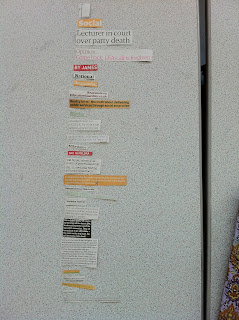Initially I was contemplating the first question...
Focussing on specific examples, describe the way that Modernist Art & Design was a response to the forces of modernity?
It seemed like the most logical approach as we'd explored the modernist movement in more depth than the other subject matters.
Using the Internet and Library as my referencing sources I choose 5 potential books to use...
1. NO MORE RULES - GRAPHIC DESIGN AND POST-MODERNISM - RICK POYNOR
LIBRARY CLASSIFICATION - 741.6
ISBN - 1856692299
2. GRAPHIC DESIGN - A NEW HISTORY - TEPHEN ESKILSON
GOOGLE BOOKS
3. 'THE BAUHAUS GROUP: SIX MASTERS OF MODERNISM' NEW YORK, RANDOM HOUSE - WEBER, NICHOLAS FOX
LIBRARY CLASSIFICATION - 709.43
4. 'ARCHITECTURES: MODERNISM AND AFTER' OXFORD, BLACKWELL. BALLANTYNE, ANDREW.
LIBRARY CLASSIFICATION - 724.9
5. 'PIONEERS OF MODERN GRAPHIC DESIGN: A COMPLETE HISTROY. 'LONDON, MITCHELL BEAZLEY. AYNSLEY, JEREMY.
LIBRARY CLASSIFICATION - 741.605
Despite finding these sources, I'm still not 100% definite on the essay question I'll proceed with, although it would be a suitable question to choose, I think a more interesting topic would be; Could it be argued that fine art ought to be assigned more 'value' than graphic design? It has a strong subject matter behind it and would also make better reading in my opinion. Fine art is not an easily definable subject and to say that both are exclusive fields would be incorrect, they both spill into one another and are reflective parts of our society and culture.
Potential Sources (This list will be added too as there's more light shone on the subject matter)
J Storey, (2006) Cultural Theory and Popular Culture , (Pearson Education)
Matthew Arnold, (1960) Culture & Anarchy














































